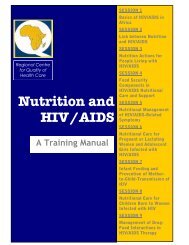2.1: Anthropometric Indicators Measurement Guide - Linkages Project
2.1: Anthropometric Indicators Measurement Guide - Linkages Project
2.1: Anthropometric Indicators Measurement Guide - Linkages Project
You also want an ePaper? Increase the reach of your titles
YUMPU automatically turns print PDFs into web optimized ePapers that Google loves.
Malnutrition Classification Systems<br />
The cut-off points for different<br />
malnutrition classification systems are<br />
listed below. The most widely used system<br />
is WHO classification (Z-scores). The<br />
Road-to-Health (RTH) system is typically<br />
seen in clinic-based growth-monitoring<br />
systems. The Gomez system was widely<br />
used in the 1960s and 1970s, but is only<br />
used in a few countries now. An analysis<br />
of prevalence elicits different results from<br />
different systems. These results would not<br />
be directly comparable. The difference is<br />
especially broad at the severe malnutrition<br />
cut-off between the WHO method (Zscores)<br />
and percent of median methods. At<br />
60% of the median the closest<br />
corresponding Z-score is –4. The WHO<br />
method is recommended for analysis and<br />
presentation of data (see Part 6.2).<br />
Mild, moderate and severe are different<br />
in each of the classification systems listed<br />
below. It is important to use the same<br />
system to analyze and present data. The<br />
RTH and Gomez classification systems<br />
typically use weight-for-age.<br />
System Cut-off Malnutrition classification<br />
WHO < -1 Z-score mild<br />
< -2 Z-score moderate<br />
< -3 Z-score severe<br />
RTH ≥ 80% of median normal<br />
60% - < 80% of median mild-to-moderate<br />
< 60% of median severe<br />
Gomez ≥ 90% of median normal<br />
75% - < 90% of median mild<br />
60% - < 75% of median moderate<br />
≤ 60% of median<br />
severe<br />
6.<br />
42

















